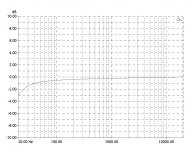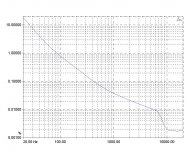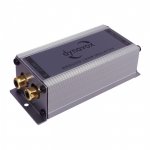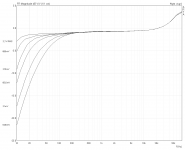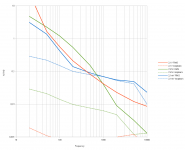Ground loop isolators are usually simple audio transformers. As such, unless they are made of very expensive esoteric core materials, or made very large, their low frequency performance will be poor. This is well known in the pro audio community, which is why transformers have largely given way to semiconductor balanced line drivers and receivers.
I thought it would be interesting to test one of the GLIs that you can buy for a few £, and which are often used to solve ground loop problems in car audio. The one I bought cost £6.99 and claims to be 'High Quality'. It's around the size and shape of a D-cell.
I did the measurements on a Prism Sound dScopeIII, and drove the GLIs with a sine test signal of 2V rms, which is typical line level. Output impedance of the dScope generator was set to 50 ohms, to be representative of a typical line output stage. Input impedance of the sDcope analyser was set to 100K and parallelled with a 10k resistor, to be representative of amplifier input impedance.
As can be seen in the attachments, the frequency response is not too bad, as it's -3dB at 20Hz and relatively flat above this. The THD+N, however, is another story altogether. Below 100Hz it is exactly what one would expect from a small, cheap audio transformer: disgraceful. Above 1kHz it's perfectly acceptable, but at 50Hz it's 3% and at 20Hz it's 17%!
When I subjected the GLI to a listening test between a preamp and power amp, I found the bass to be quite sloppy. The 'golden ear audiophiles' might describe it as indecisive.
So think carefully before installing a GLI in any high quality audio system.
I thought it would be interesting to test one of the GLIs that you can buy for a few £, and which are often used to solve ground loop problems in car audio. The one I bought cost £6.99 and claims to be 'High Quality'. It's around the size and shape of a D-cell.
I did the measurements on a Prism Sound dScopeIII, and drove the GLIs with a sine test signal of 2V rms, which is typical line level. Output impedance of the dScope generator was set to 50 ohms, to be representative of a typical line output stage. Input impedance of the sDcope analyser was set to 100K and parallelled with a 10k resistor, to be representative of amplifier input impedance.
As can be seen in the attachments, the frequency response is not too bad, as it's -3dB at 20Hz and relatively flat above this. The THD+N, however, is another story altogether. Below 100Hz it is exactly what one would expect from a small, cheap audio transformer: disgraceful. Above 1kHz it's perfectly acceptable, but at 50Hz it's 3% and at 20Hz it's 17%!
When I subjected the GLI to a listening test between a preamp and power amp, I found the bass to be quite sloppy. The 'golden ear audiophiles' might describe it as indecisive.
So think carefully before installing a GLI in any high quality audio system.
Attachments
Have you ever seen the accoustic FR of the average car? 😱
Transformer distortion will be totally buried in those aberrations !
Transformer distortion will be totally buried in those aberrations !
Have you ever seen the accoustic FR of the average car? 😱
Transformer distortion will be totally buried in those aberrations !
No it won't. GLI's severely degrade the sound. Unless you are running straight pipes on your car then deficiencies in a high end system can easily be detected.
I agree with most of what your posting and saying just by audio testing with my ears. but you might want to look at the king of the hill of these also, Please check the link below:
JENSEN TRANSFORMERS, INC. - ISO-MAX® Audio Isolator Products
These are Studio grade transformers, a bit pricey but the quality is there also.....I hate ISO transformers but I Hope this info helps someone....🙂
JENSEN TRANSFORMERS, INC. - ISO-MAX® Audio Isolator Products
These are Studio grade transformers, a bit pricey but the quality is there also.....I hate ISO transformers but I Hope this info helps someone....🙂
No it won't. GLI's severely degrade the sound. Unless you are running straight pipes on your car then deficiencies in a high end system can easily be detected.
"Severely degrade ...."
The OP shows 1% THD at 100H or less
Get a grip mate! WTF are you listening to in your 2 M^3 boom box?
Here is the Jensen link to all of their public white papers on transformers and core materials versus distortion. Lots of good reading and info. You will be a magnetic specialist after reading their information pdf's. They do explain a lot of what you were talking about.....🙂
JENSEN TRANSFORMERS, INC. - APPLICATION PAPERS AND SCHEMATICS
JENSEN TRANSFORMERS, INC. - APPLICATION PAPERS AND SCHEMATICS
Hi, ThreadDigger TM here  ...
...
I've acquired one of those cheap china transformer isolators, too, out of curiosity. Put it between input and output of my soundcard (ESI Juli@) and made some distortion measurements at different voltage levels. Software used was ARTA, set to 48kHz sample rate, ~131k FFT, 8 averages, ASIO. Nothing new here I guess, but I found it interesting to see the frequency response change that much with level, so I thought I'd share it here.
 ...
...I've acquired one of those cheap china transformer isolators, too, out of curiosity. Put it between input and output of my soundcard (ESI Juli@) and made some distortion measurements at different voltage levels. Software used was ARTA, set to 48kHz sample rate, ~131k FFT, 8 averages, ASIO. Nothing new here I guess, but I found it interesting to see the frequency response change that much with level, so I thought I'd share it here.
Attachments
- Status
- Not open for further replies.
- Home
- General Interest
- Car Audio
- Ground Loop Isolators exposed
